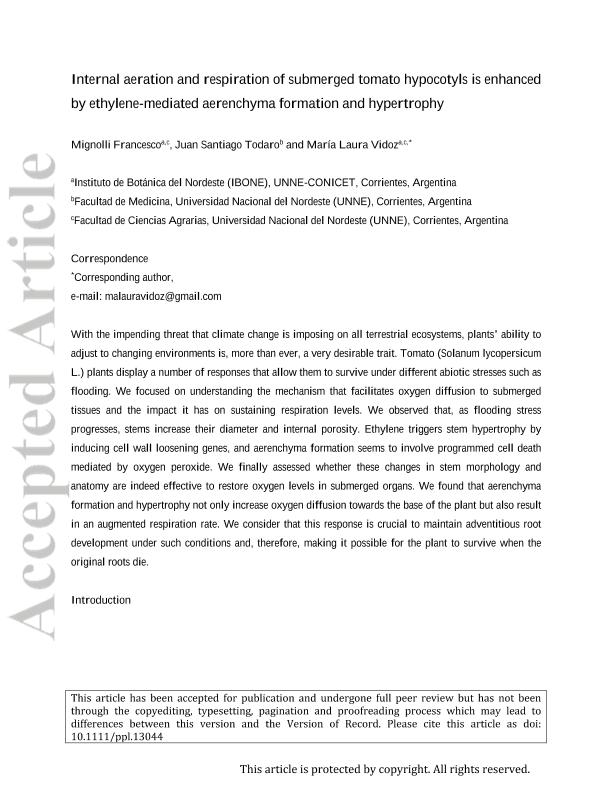Mostrar el registro sencillo del ítem
dc.contributor.author
Mignolli, Francesco

dc.contributor.author
Todaro, Juan Santiago

dc.contributor.author
Vidoz, María Laura

dc.date.available
2020-06-09T15:39:16Z
dc.date.issued
2019-11
dc.identifier.citation
Mignolli, Francesco; Todaro, Juan Santiago; Vidoz, María Laura; Internal aeration and respiration of submerged tomato hypocotyls is enhanced by ethylene‐mediated aerenchyma formation and hypertrophy; Wiley Blackwell Publishing, Inc; Physiologia Plantarum; 11-2019; 1-28
dc.identifier.issn
0031-9317
dc.identifier.uri
http://hdl.handle.net/11336/107028
dc.description.abstract
With the impending threat that climate change is imposing on all terrestrial ecosystems, plants ability to adjust to changing environments is, more than ever, a very desirable trait. Tomato (Solanum lycopersicum L.) plants display a number of responses that allow them to survive under different abiotic stresses such as flooding. We focused on understanding the mechanism that facilitates oxygen diffusion to submerged tissues and the impact it has on sustaining respiration levels. We observed that, as flooding stress progresses, stems increase their diameter and internal porosity. Ethylene triggers stem hypertrophy by inducing cell wall loosening genes, and aerenchyma formation seems to involve programmed cell death mediated by oxygen peroxide. We finally assessed whether these changes in stem morphology and anatomy are indeed effective to restore oxygen levels in submerged organs. We found that aerenchyma formation and hypertrophy not only increase oxygen diffusion towards the base of the plant but also result in an augmented respiration rate. We consider that this response is crucial to maintain adventitious root development under such conditions and, therefore, making it possible for the plant to survive when the original roots die.
dc.format
application/pdf
dc.language.iso
eng
dc.publisher
Wiley Blackwell Publishing, Inc

dc.rights
info:eu-repo/semantics/openAccess
dc.rights.uri
https://creativecommons.org/licenses/by-nc-sa/2.5/ar/
dc.subject
TOMATO
dc.subject
FLOODING STRESS
dc.subject
ETHYLENE
dc.subject
AERENCHYMA
dc.subject.classification
Ciencias de las Plantas, Botánica

dc.subject.classification
Ciencias Biológicas

dc.subject.classification
CIENCIAS NATURALES Y EXACTAS

dc.title
Internal aeration and respiration of submerged tomato hypocotyls is enhanced by ethylene‐mediated aerenchyma formation and hypertrophy
dc.type
info:eu-repo/semantics/article
dc.type
info:ar-repo/semantics/artículo
dc.type
info:eu-repo/semantics/publishedVersion
dc.date.updated
2020-05-27T16:34:27Z
dc.journal.pagination
1-28
dc.journal.pais
Reino Unido

dc.journal.ciudad
Londres
dc.description.fil
Fil: Mignolli, Francesco. Consejo Nacional de Investigaciones Científicas y Técnicas. Centro Científico Tecnológico Conicet - Nordeste. Instituto de Botánica del Nordeste. Universidad Nacional del Nordeste. Facultad de Ciencias Agrarias. Instituto de Botánica del Nordeste; Argentina
dc.description.fil
Fil: Todaro, Juan Santiago. Universidad Nacional del Nordeste. Facultad de Medicina; Argentina
dc.description.fil
Fil: Vidoz, María Laura. Consejo Nacional de Investigaciones Científicas y Técnicas. Centro Científico Tecnológico Conicet - Nordeste. Instituto de Botánica del Nordeste. Universidad Nacional del Nordeste. Facultad de Ciencias Agrarias. Instituto de Botánica del Nordeste; Argentina
dc.journal.title
Physiologia Plantarum

dc.relation.alternativeid
info:eu-repo/semantics/altIdentifier/url/https://onlinelibrary.wiley.com/doi/abs/10.1111/ppl.13044
dc.relation.alternativeid
info:eu-repo/semantics/altIdentifier/doi/http://dx.doi.org/10.1111/ppl.13044
Archivos asociados
